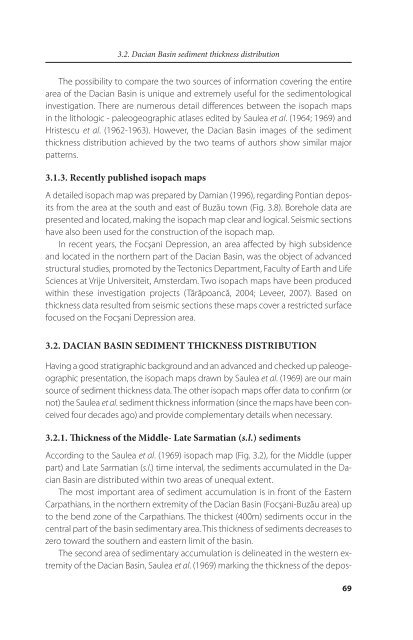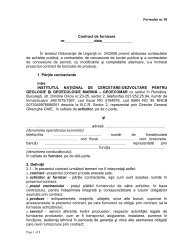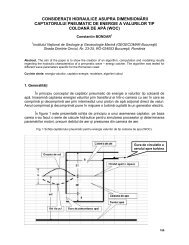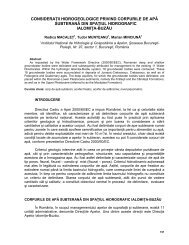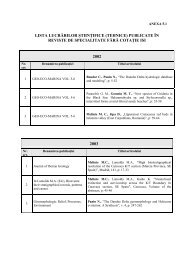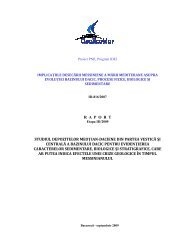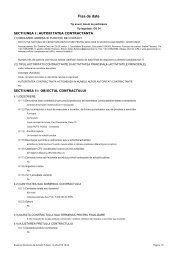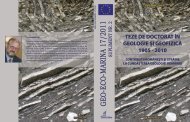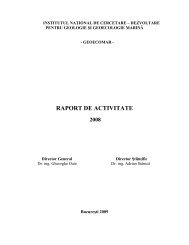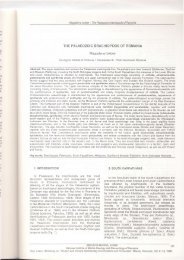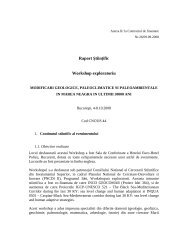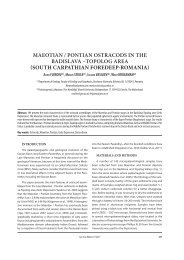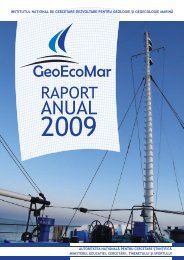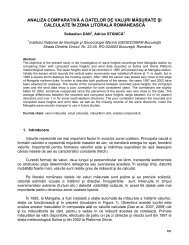DACIAN BASIN - GeoEcoMar
DACIAN BASIN - GeoEcoMar
DACIAN BASIN - GeoEcoMar
You also want an ePaper? Increase the reach of your titles
YUMPU automatically turns print PDFs into web optimized ePapers that Google loves.
3.2. Dacian Basin sediment thickness distribution<br />
The possibility to compare the two sources of information covering the entire<br />
area of the Dacian Basin is unique and extremely useful for the sedimentological<br />
investigation. There are numerous detail differences between the isopach maps<br />
in the lithologic - paleogeographic atlases edited by Saulea et al. (1964; 1969) and<br />
Hristescu et al. (1962-1963). However, the Dacian Basin images of the sediment<br />
thickness distribution achieved by the two teams of authors show similar major<br />
patterns.<br />
3.1.3. Recently published isopach maps<br />
A detailed isopach map was prepared by Damian (1996), regarding Pontian deposits<br />
from the area at the south and east of Buzău town (Fig. 3.8). Borehole data are<br />
presented and located, making the isopach map clear and logical. Seismic sections<br />
have also been used for the construction of the isopach map.<br />
In recent years, the Focşani Depression, an area affected by high subsidence<br />
and located in the northern part of the Dacian Basin, was the object of advanced<br />
structural studies, promoted by the Tectonics Department, Faculty of Earth and Life<br />
Sciences at Vrije Universiteit, Amsterdam. Two isopach maps have been produced<br />
within these investigation projects (Tărăpoancă, 2004; Leveer, 2007). Based on<br />
thickness data resulted from seismic sections these maps cover a restricted surface<br />
focused on the Focşani Depression area.<br />
3.2. <strong>DACIAN</strong> <strong>BASIN</strong> SEDIMENT THICkNESS DISTRIBUTION<br />
Having a good stratigraphic background and an advanced and checked up paleogeographic<br />
presentation, the isopach maps drawn by Saulea et al. (1969) are our main<br />
source of sediment thickness data. The other isopach maps offer data to confirm (or<br />
not) the Saulea et al. sediment thickness information (since the maps have been conceived<br />
four decades ago) and provide complementary details when necessary.<br />
3.2.1. Thickness of the Middle- Late Sarmatian (s.l.) sediments<br />
According to the Saulea et al. (1969) isopach map (Fig. 3.2), for the Middle (upper<br />
part) and Late Sarmatian (s.l.) time interval, the sediments accumulated in the Dacian<br />
Basin are distributed within two areas of unequal extent.<br />
The most important area of sediment accumulation is in front of the Eastern<br />
Carpathians, in the northern extremity of the Dacian Basin (Focşani-Buzău area) up<br />
to the bend zone of the Carpathians. The thickest (400m) sediments occur in the<br />
central part of the basin sedimentary area. This thickness of sediments decreases to<br />
zero toward the southern and eastern limit of the basin.<br />
The second area of sedimentary accumulation is delineated in the western extremity<br />
of the Dacian Basin, Saulea et al. (1969) marking the thickness of the depos-<br />
69


